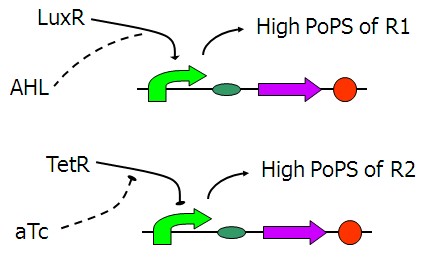USTC/Inputs and Outputs
From 2007.igem.org
PoPS (the flow of RNA Polymerase molecules along DNA) means the current of gene expression. Our logic gates accept PoPS input signals, but we cannot input a PoPS signal directly. We decide to add something into our system as input signal, such as cheminal ligands and light. So a convertor must be built firstly to convert these signals to PoPS signals.
Contents |
Candidates of input signals
Light
We decide not to use light signals as the inputs of our system for the following two reasons.
For one, it would be rather difficult to dynamically control the light intensity in real experiments. Compared with simply adding reagents to the solutions, controlling the input level of light is far more complicated. Still unpleasant is the requirement for the techniques of keeping the light sensors on the cell membrane from frequent exposure.
For another, since light has seldom been applied as input signals before, there is little relative background knowledge and experience to help us.
IPTG
IPTG is actually the RESET signal of the whole system. Once added, it will let all the repressor-operator pairs in the system no longer function. All the outputs will consequently become 1 as well as all the input repressing signals being automatically ignored. (It just likes the "8888..." on the screen when you reset your calculator or some other digital equipment.)
aTc
ATC is a well studied and widely used inducer of cellular communication. We take a fancy to its stable properties and reasonable price. Certainly, there are still some problems, for example, aTc at a high concentration shows some bacteriostatic activity like Tc. Unfortunately we have to use concentrated aTc for counteracting the high expression of TetR repressor protein.
AHL
We consider AHL a well-qualified input signal that is normally used in quorum sensing. Actually, we choose 3OC6HSL, a member of AHL family to be the input signal, and its according receptor LuxR to be the sensor. Here we find it no problem to use dilute AHL althought LuxR is also high expressing, because LuxR is activator and AHL is its accelerator.
Arabinose
Considering that the promoter of arabinose requires to match and is too much limited by the genotype of the host strain, we finally give up the idea that arabinose would serve as an input signal.
Design of PoPS converters
The figure above shows the basic structure of our input device. It functions to convert the input chemical signals to the PoPS (the flow of RNA Polymerase molecules along DNA) signals of the lac repressor A and B, the wires that will actually connect the two main parts of our system together.
PoPS-converter parts
Figure 2 is the first design of our [aTc]->PoPS converter. Fluorescent reporters was added behind. However, we found that the background expression could not be ignored under the fluorescent microscope. It might be due to the LVA tag of Tet repressor which served to help TetR degrade. Therefore, we decide to remove the LVA tag of the Tet repressor like the one shown in Figure 3.
We take [http://partsregistry.org/Part:BBa_J09855 BBa_J09855] directly from the registry as [AHL]->PoPS converter. Fluorescent expression under different [3OC6HSL] has been tested and the results show that this part is a perfect input device in this study.


